Everything You Need to Know Before Hiking the Tour du Mont Blanc
Striking mountain views, colourful alpine flowers, magnificent ancient glaciers, rustic mountain huts, picturesque towns, delicious food and so much more. Here’s everything you need to know about hiking the Tour du Mont Blanc.
The Tour du Mont Blanc (TMB) is one of Europe’s most famous long-distance treks and you’ll find it in The Alps. It covers approximately 170 kilometres and over 10,000 metres of elevation gain as it encircles the magnificent Mont Blanc Massif.
Mont Blanc stands at a whopping 4,809 metres, making it the tallest mountain in the European Alps!
As you hike through France, Italy and Switzerland, you’ll be treated to magnificent views across endless mountain peaks, impressive ancient glaciers, quaint villages, snow-capped mountains, pretty alpine meadows, lush forests and many more diverse landscapes.
Hiking the Tour du Mont Blanc is one of the most rewarding and challenging things we’ve done. It took months of research and planning and there were still some things we wished we knew before the trip, which is why we’ve written this guide.
In this guide, we’ll cover everything you need to know before hiking the Tour du Mont Blanc including the best time of year, types of accommodation, when to book, water refill, ATM and food points and so much more so dig in and prepare for the trip of a lifetime!

No time to read this post on everything you need to know before hiking the Tour du Mont Blanc now? Save it for later!


Contents
The Best Time of Year for Hiking the Tour du Mont Blanc
The Tour du Mont Blanc hiking season runs between May and September with the best time to hike being early to mid-July or September.
In May and June, there’ll be quite a lot of snow and some sections won’t be passable without crampons. Even on 11th July, it was questionable whether we could hike over Col des Fours at 2665 metres in hiking shoes.
Fortunately, we were able to, however, 2 days earlier, we’d have needed crampons or taken a different route.
Towards the end of July and throughout August, the trails will be very busy and prices will increase due to the school holidays. Temperatures will also increase which isn’t ideal when hiking for 6-8 hours a day!
Between mid-June to mid-July, landscapes are filled with beautiful, colourful alpine flowers.
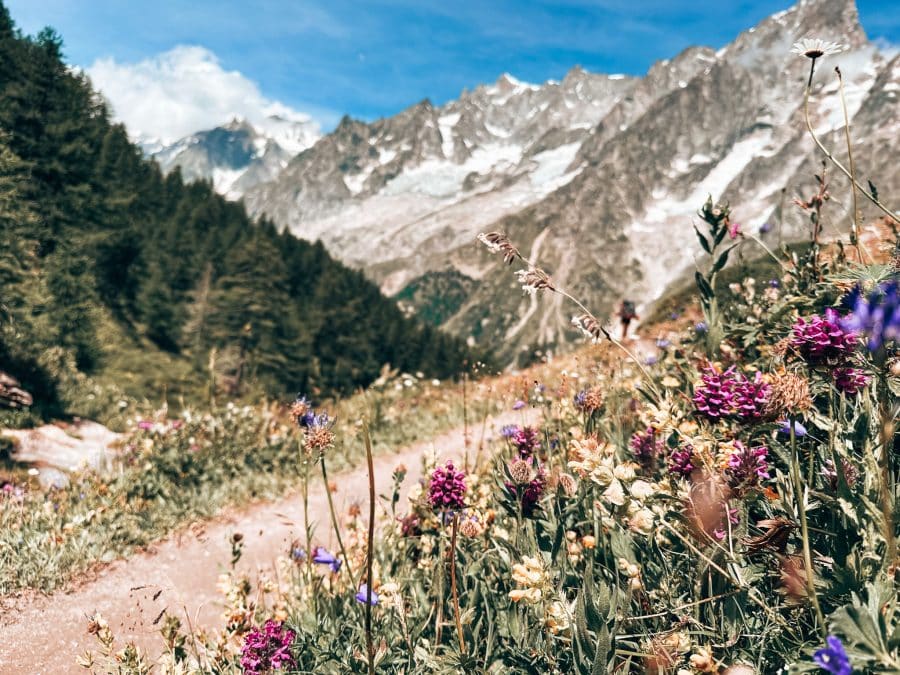
Weather When Hiking the Tour du Mont Blanc
Whatever time of the year you are hiking the Tour du Mont Blanc, the weather is unpredictable and can change without a moment’s notice so be prepared and pack for all eventualities!
At the start and end of the season, you may encounter snow storms so keep this in mind when deciding on layers, footwear and whether you need to take crampons.
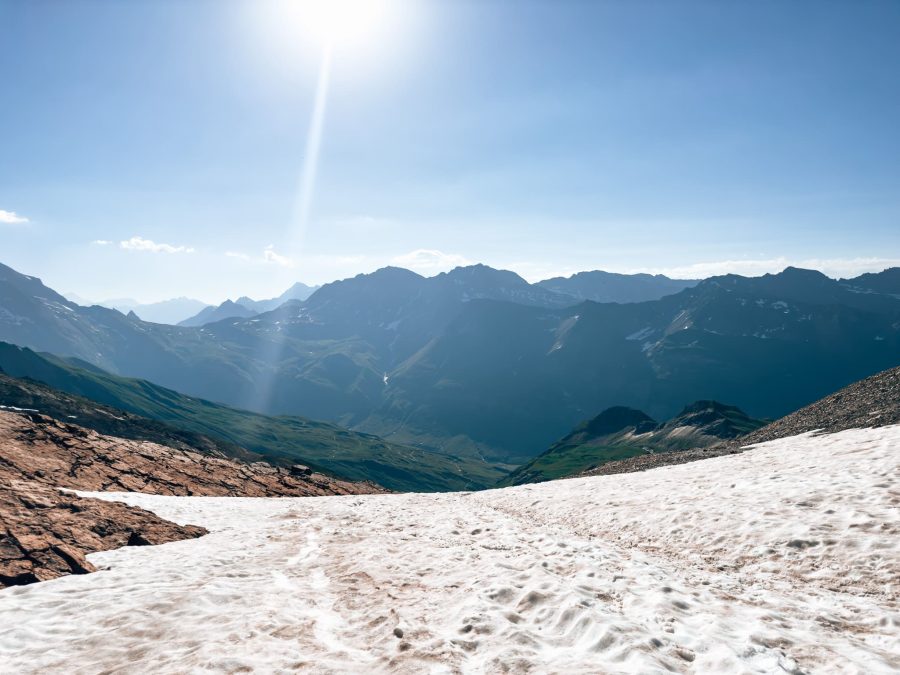
Temperatures in June and September will be more bearable for hiking, ranging between 9 and 24 degrees Celsius. The evenings will be cold, especially in the mountains so take thermals and plenty of warm layers.
In July and August, temperatures range from around 12 to 26 degrees Celsius so you can comfortably hike in shorts and t-shirts. Evenings will still be chilly. There may also be some snow high up from mid-July, but perfectly manageable without crampons.
The average rainfall is similar over the summer months ranging between 60mm and 70mm on average. We were fortunate in that we didn’t need our raincoats, however, we met people who encountered rain and thunderstorms every day!
Saying that, however, storms are more likely in the evenings and overnight. We experienced some fairly epic thunderstorms that lit up the vast mountain peaks which was incredibly exciting!
The Best Direction For Hiking the Tour du Mont Blanc
The Tour du Mont Blanc Hike starts and ends (technically) in Les Houches.
The most popular and traditional route is hiking anti-clockwise although it can be hiked clockwise which is a good option to avoid some of the crowds in the mornings and afternoons.
The views are spectacular in whichever direction you choose so this shouldn’t impact your choice. We hiked anti-clockwise as it’s the most popular route. We also finished the hike before Les Houches so for us, clockwise wouldn’t have worked (more on that below).
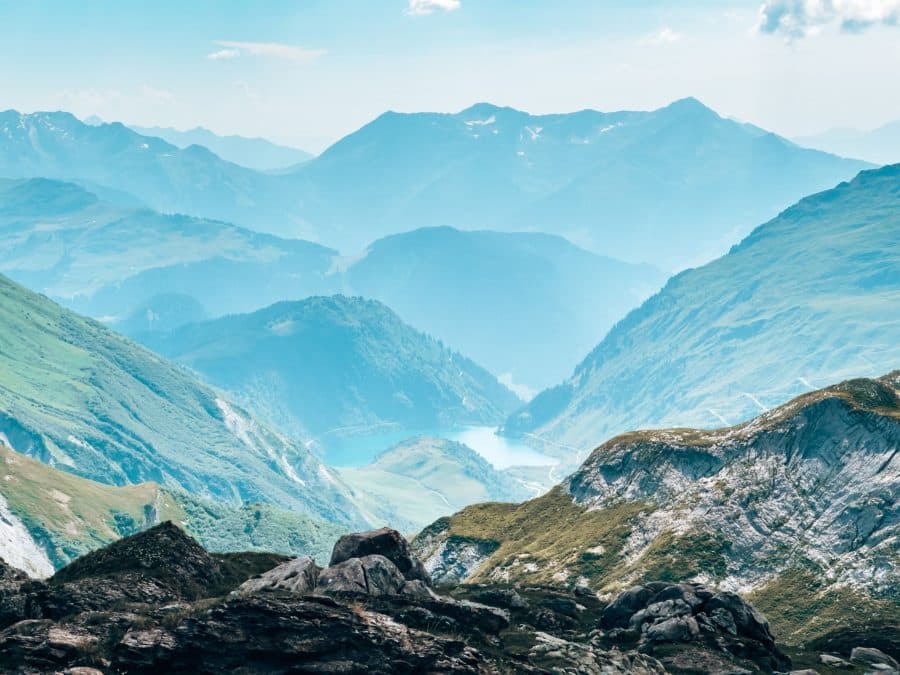
How Long Does Hiking the TMB Take and How Long is the Entire Route?
The entire TMB Hike starting and ending in Les Houches is approximately 170 kilometres and involves around 10 kilometres of ascent and descent. The elevation gain of the Tour du Mont Blanc is more than summiting Everest!!
The numbers vary as it depends on your route and variations, whether you take any public transport and if you return to Les Houches. The last section before Les Houches is a gruelling downhill knee-grinder through the forest so there are other options to end.
Hiking the TMB can take anywhere between 6 and 14 days depending on how much time you have, your pace, your route and how many rest days you take.
Our Tour du Mont Blanc itinerary was 11 days with a rest day on day 5 in Courmayeur which we thought was ideal. The toughest days were the first 3 so a chilled day on day 5 was needed.
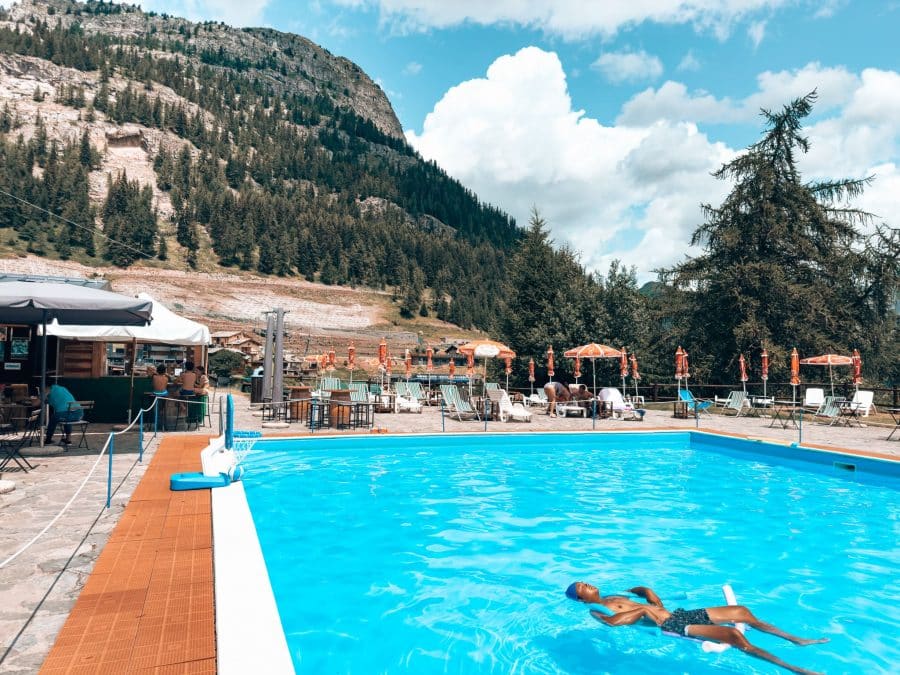
How Well is the TMB Signposted?
There are signs everywhere when hiking the Tour du Mont Blanc.
Signs will say TMB which will differentiate them from other hiking routes. They’ll be placed on poles, rocks, trees, paths, walls and various other parts of the trails and differ in each country.
In France, look out for a red and white line. Go straight if they’re parallel, turn in the direction they’re pointing or, if they’re a cross, the route isn’t in that direction.
In Italy, the markings are yellow arrows, circles, lines, triangles and diamonds with a black border.
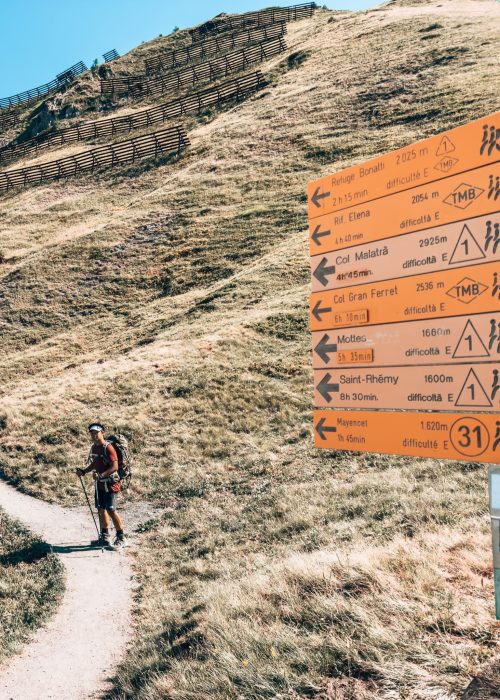
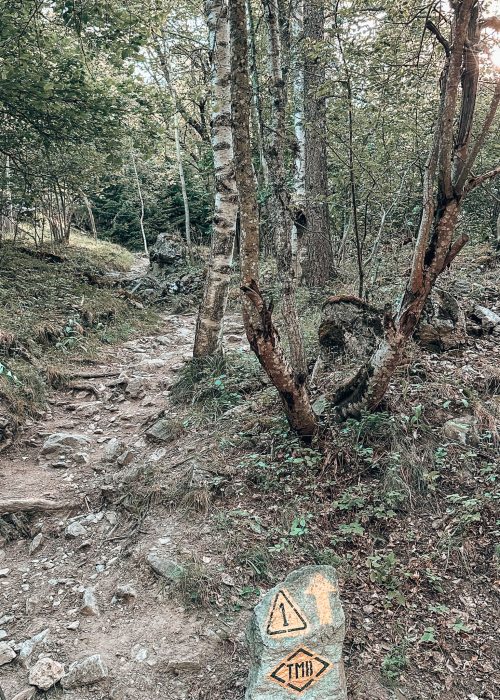
Finally, in Switzerland, yellow signs indicate hiking routes with no technical difficulties and white-red-white markers highlight routes that may be exposed or technical.
Although the route is well-signposted, make sure you still bring a map with you.
Our Top Tip: timings on these signs aren’t at all accurate. Occasionally, the timings actually increased as we got closer to the direction they were pointing so don’t pay attention to them.
Accommodation when Hiking the Tour du Mont Blanc
When hiking the TMB, you’ll be presented with a range of accommodation options, styles and prices.
Mountain Refuges
If you plan on hiking the entire route without taking any transport, you’ll more than likely stay in at least a couple of mountain refuges. These are huts high in the mountains, generally only accessible by foot.
In the huts are dorm rooms ranging from around 4 – 25 beds and some also have private rooms. Bathrooms are normally shared amongst everyone in the refuge.
The cost for a bed in a dorm ranges between around €50-€70 a night on a half-board basis and there’s usually the option of adding on a packed lunch for another €10-€15. Private rooms in refuges are around €85 per person half-board.
Keep reading and we’ll share some tips for staying in refuges.
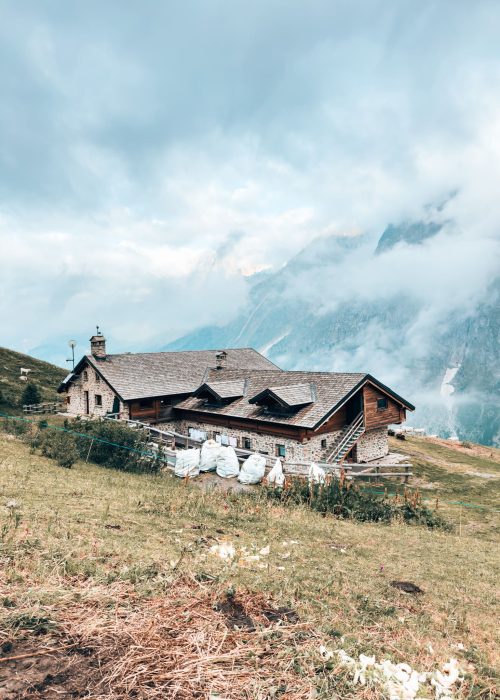
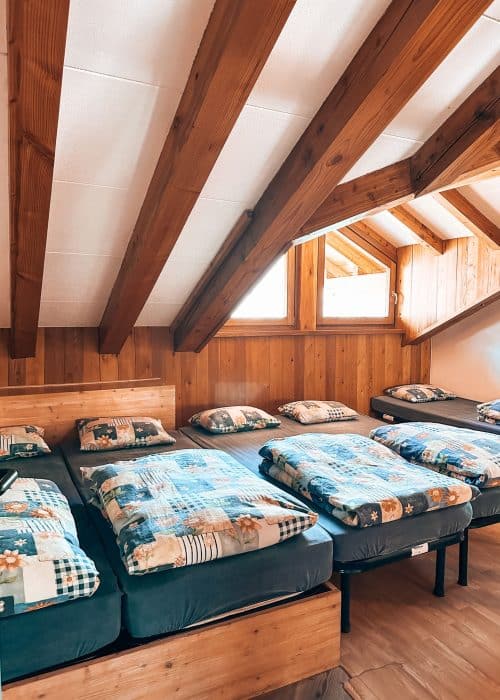
Hotels
When hiking the Tour du Mont Blanc, you’ll pass through towns and villages where it’s possible to stay. As well as refuges, you’ll also find hotels with a bit more luxury.
Hotels tend to be on a bed-and-breakfast basis, or there’s the option of adding breakfast on arrival. There’s probably a restaurant for dinner and there may be other restaurants close by depending on the size of the town.
Towels and sheets are usually provided so you don’t need to rely on bringing a sleeping bag liner.
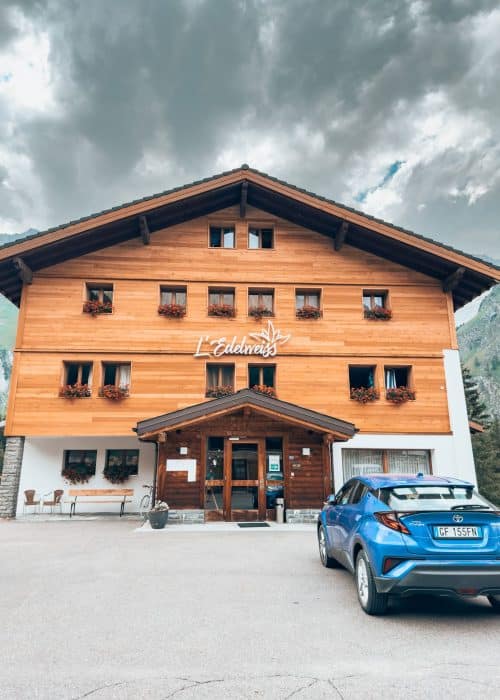
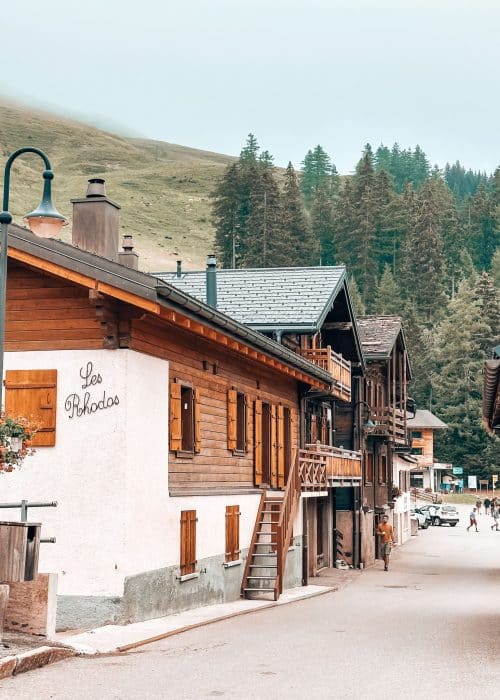
Apartments
In towns along the TMB, you’ll also find some lovely apartments, usually bookable on Airbnb or Booking.com.
We stayed in some lovely apartments in Les Contamines, Courmayeur and Champex-Lac close to the towns’ amenities. One advantage of staying in an apartment is that there are usually washing facilities if you’re running out of clean clothes.
Another option is camping which we’ll tell you more about below.
Can I Camp Along the TMB?
Camping when hiking the Tour du Mont Blanc is quite popular, especially if you’re hiking with your dog (more on that later). It’s also a great way to save money and you’ll be rewarded with some seriously epic views!
France, Italy and Switzerland each have their own camping rules, however.
France is the best for wild camping so rather than having a set destination for the end of your day, you can continue on until you feel like it or find a spot you want to camp at.
Wild camping near a refuge is quite common as there’ll be a water supply. There are also free designated camping spots that sometimes come with water and toilets.
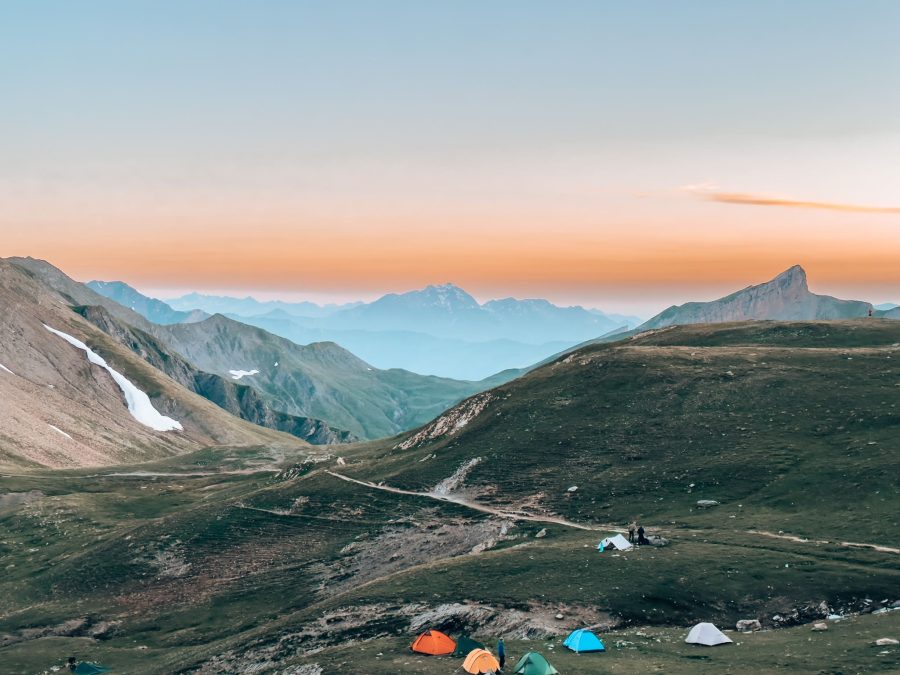
In Italy, wild camping is generally banned, however, each region has its own rules. Along the TMB it’s generally accepted you can wild camp above 2500 metres between dusk and dawn, however, this isn’t a rule and you do so at your own risk.
Fines range anywhere between €100 and €500.
In Switzerland, wild camping is illegal full stop.
In all countries, you can book campsites or pitch on private land with the owner’s consent.
How do I Book the Tour du Mont Blanc Hike?
There are a variety of ways to book the TMB hike. Here, we’ll share the pros and cons of each and how we booked it.
- Book everything yourself – what we did
- Self-guided tour
- Guided tour
Book everything yourself
This is what we did and we’d do it this way again as it gives you complete control over your route and accommodation. It’s also the cheapest way of hiking the Tour du Mont Blanc.
Booking everything yourself is very time-consuming so be prepared for a lot of trip research. This wasn’t a problem for us as we love planning trips and can’t wait to see them come to life.
Doing all of the research and planning yourself can be quite daunting as there are numerous accommodation styles, there are no set stages so everyone’s routes are slightly different, stages have variations and the hike can be done in varying amounts of time.
This guide and our Tour du Mont Blanc itinerary will take most of that off your hands as we’ll provide you with everything you need to know. However, you’ll need to decide your chosen route and accommodation based on your preferences.
We’d also recommend buying the Cicerone: Trekking the Tour of Mont Blanc guidebook and this paper map to carry with you. Routes are well sign-posted but they’re handy for planning your day and definitely worth having just in case.
Our Top Tip: timings in the above guidebook don’t include breaks so bear that in mind when planning your day.
Book everything no later than February for the summer! Accommodation sells out fast and the later you book, the more flexible you’ll have to be on route, timings, dates and accommodation. You may even have to stay off the trail and take public transport.
Accommodation has to be booked individually, with some online, some over the phone and some via email. Some will require deposits and others cash on arrival.
If you’d like to do the planning and hiking yourself but you’re worried about carrying a heavy backpack, you can book luggage transfers. Some refuges are, understandably, inaccessible so you might have to take the odd overnight bag but not often.
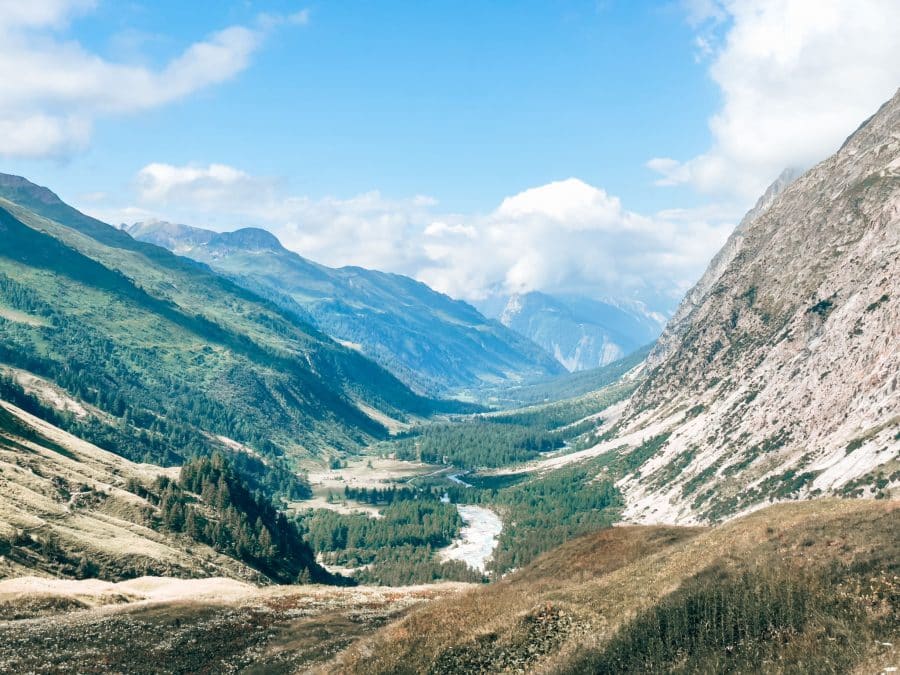
Self-guided tour
This is a great option if you’d like most of the planning removed but you still want to hike independently. All accommodation is booked through the tour operator based on your requirements.
Most of the costs are also taken care of so you’ll only need money for a few extra meals, drinks, and any transport should you decide to take any.
The tour operator should also provide you with maps and a detailed stage-by-stage itinerary so you don’t even need to plan your hike each day.
Our Top Tip: there are a lot of tour operators out there so make sure you do your research. We heard stories of people being disappointed as some companies didn’t provide enough information.
Guided tour
Finally, the third option is to book a guided tour. This is a good option if you’re a solo hiker and don’t feel comfortable hiking on your own or you’d like some company.
If you’re in a group, we don’t think this is necessary. The trails are very well sign-posted, the paths are well-maintained and you can hike at your own pace.
We saw quite a few tour groups hiking the Tour du Mont Blanc and as you can’t guarantee everyone’s fitness levels, public transport was often taken to ensure you reached the next point by the end of the day. Not a bad thing but something to bear in mind.
How Fit Do I Need to be to Hike the TMB?
Although a challenging hike with significant ascent and descent, hiking the Tour du Mont Blanc doesn’t require extreme fitness unless you’re planning on covering the entire route in a week. A reasonable level of cardio fitness is needed along with leg strength.
You should be an experienced hiker and start some kind of training at least 6 months prior to your trip.
We’re quite active but live in London so couldn’t exactly hike up mountains every week to train. Andy does a lot of spinning and I cycle and use the stair climber in the gym alongside strength training.
Two months before hiking the Tour du Mont Blanc, we spent a long weekend in the Brecon Beacons and hiked for three consecutive days as we hadn’t done this before. We also hiked around London with 10kg weights in our backpacks to build up our strength.
Our fitness was absolutely fine and it’s built up very quickly within the first few days as well.
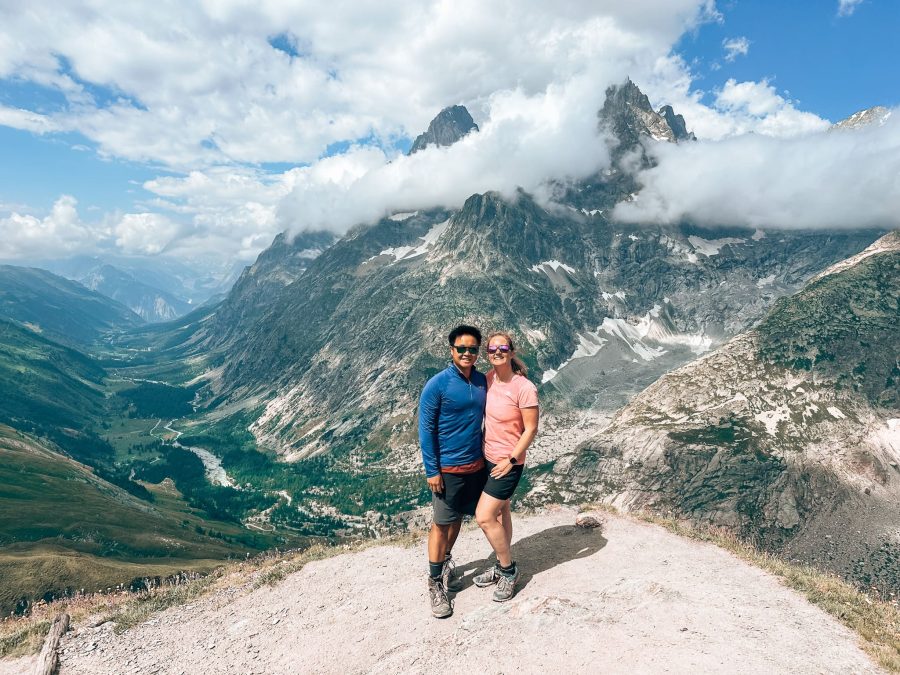
Tips for Staying in Mountain Refuges
If, like us, you’re hiking the Tour du Mont Blanc and you’ve never stayed in a mountain refuge before, here are some tips:
- Hiking shoes must be taken off on arrival and stored in the boot room so make sure you have a spare pair of shoes/flip flops. A lot of websites suggest slippers which we took literally so we took slippers as well as flip-flops and never wore them. Birkenstocks worked perfectly.
- Arrive at the refuge by 6pm or risk being turned away. Most refuges only accept cash payments so will only hold your bed until 6pm as they need to reduce the risk of losing money. People will risk turning up to refuges without a reservation in the hope that people haven’t turned up and they will be allocated your bed if you’re not there. We saw people being turned away late as there were no beds for them. Yes, you can be turned away from refuges even in the mountains so factor this into your timings. Also, dinner is usually served to everyone around 7pm and if you arrive late you also risk not eating.
- In most refuges, it’s mandatory to sleep in your own sleeping bag liner so take one with you. They’re super light and don’t take up much space. You’ll also need your own towel.
- You’ll most likely be sleeping in dorm rooms, some of which have around 20 beds so earplugs, a torch for late night and an eye mask are useful.
- Be considerate to your fellow hikers. People will start going to bed straight after dinner so if you’re staying up a bit later, bear in mind people may be sleeping. And, if you’re up early, pack up quietly.
- Don’t expect luxury showers and toilets. Water is limited in the mountains so you’re often given a token that will give you a limited amount of hot water. Once this runs out, it’s glacial! Even with a token, you’re not guaranteed hot water. You’re actually not guaranteed water at all! At one refuge on our TMB hike, there was no water in the showers at all. We improvised and splashed ourselves with the glacier water in the water trough outside!
- If you have any dietary requirements or allergies, let the refuge know as soon as possible. Supplies often arrive by donkey and not every day so they need to be prepared with what food to bring.
- Refuges are usually on a half-board basis with dinner and breakfast included. If you want a packed lunch, order this before dinner so they can prepare them.
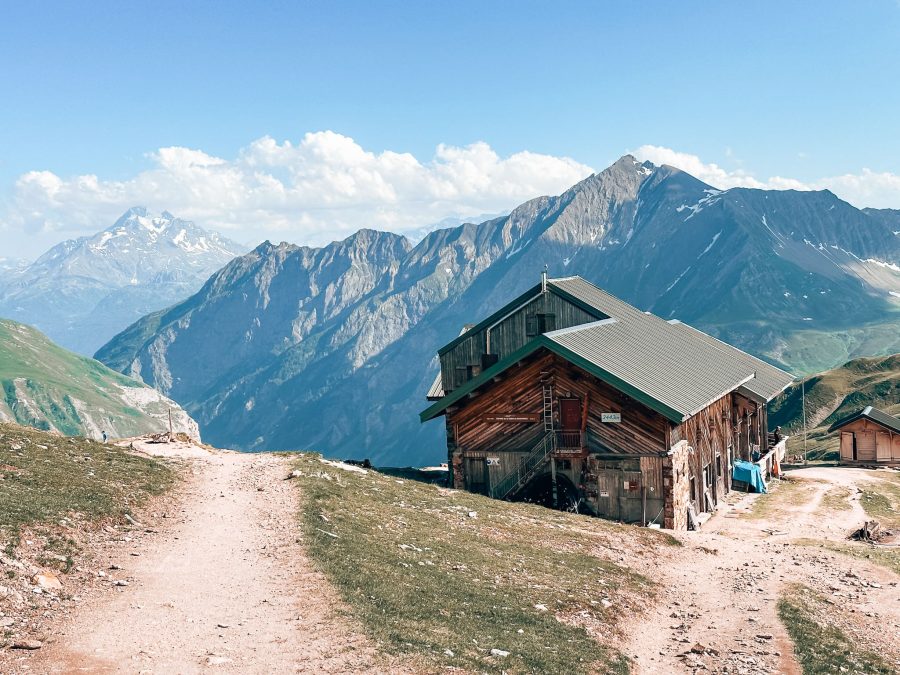
Food and Drink Along the TMB
One of the best things we found when hiking the Tour du Mont Blanc is that we could eat practically anything and not feel guilty as we were doing so much exercise. This was great as the food along the TMB Hike is hearty, delicious and calorific!
Below, we’ll share where to get food along the TMB Hike and here we’ll share a bit about what to expect for each meal.
90% of meals consist of cured meats, cheese and bread and how this is consumed varies across each meal.
Breakfast in all accommodation and bakeries is always very similar – meats, cheeses, breads, jam, cereals, fruit and yoghurt. Lunch is usually a ham and cheese sandwich, fruit, a granola bar and a packet of crisps.
Dinner is always an absolute guilt-free treat!
We were slightly concerned that dinners in the refuges weren’t going to consist of much, however, we were very glad to be proven wrong.
Dinners are at least 3, sometimes 4 courses and usually involve salad, cheese, meats and bread to start, a meat/veg pasta dish for the main and a homemade sugary treat for dessert.
In towns, cheese raclette and fondue are big staples for the entire TMB Hike. These are served with bread, vegetables, potatoes and meats and are absolutely delicious!! Pizza and pasta are also very common.
If you’re a vegetarian, meals take a bit more planning. All the refuges can cater easily, however, you may struggle in the smaller towns to buy sandwiches. One of our party is a vegetarian and she would buy the ingredients and make up the sandwich herself.
If you’re vegan, this would take more planning again as cheese is a huge staple in this region. Cheese is also high in protein so if you’re a vegetarian you can at least rely on this for energy.
You’ll definitely be able to find food but you’ll need to really think about what you’re eating to make sure you’re consuming enough calories and getting enough protein to sustain what you’re burning in the day. Avocado or chickpea smash is a good sandwich filler.
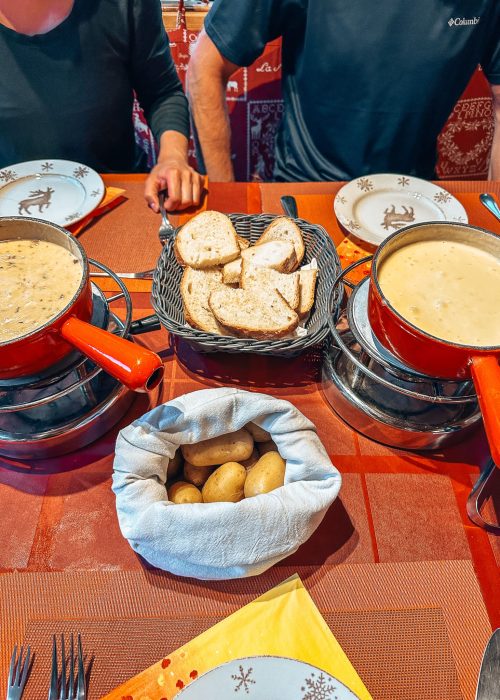
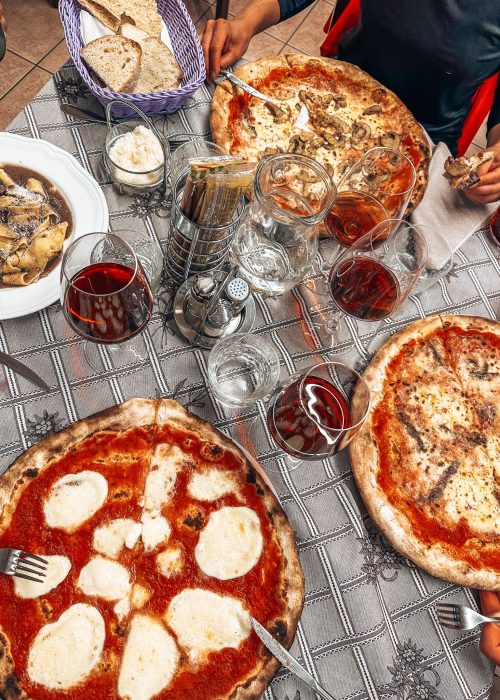
Where to Get Food Along the TMB Hike
Where to get food while you’re hiking the Tour du Mont Blanc depends on your route and accommodation.
Mountain refuges usually come on a half-board basis with the option of buying a packed lunch for the next day which usually consists of a sandwich, crisps, granola bar, a piece of fruit and a drink for approximately €10.
Don’t solely rely on the packed lunches from refuges, there’s not enough for the day so you at least need to buy some high-calorie snacks. If you’re going to be in the mountains for a few days and not visit a town, we’d recommend buying food for a few days.
In towns, there are supermarkets where you can stock up on snacks and you’ll also find ready-made sandwiches or fresh bread and fillings to make sandwiches yourself.
If you’re camping, you’ll probably need to cook dinner and breakfast for yourselves unless you’re staying close to a town with restaurants. Sometimes you can camp next to a refuge and pay for meals from them.
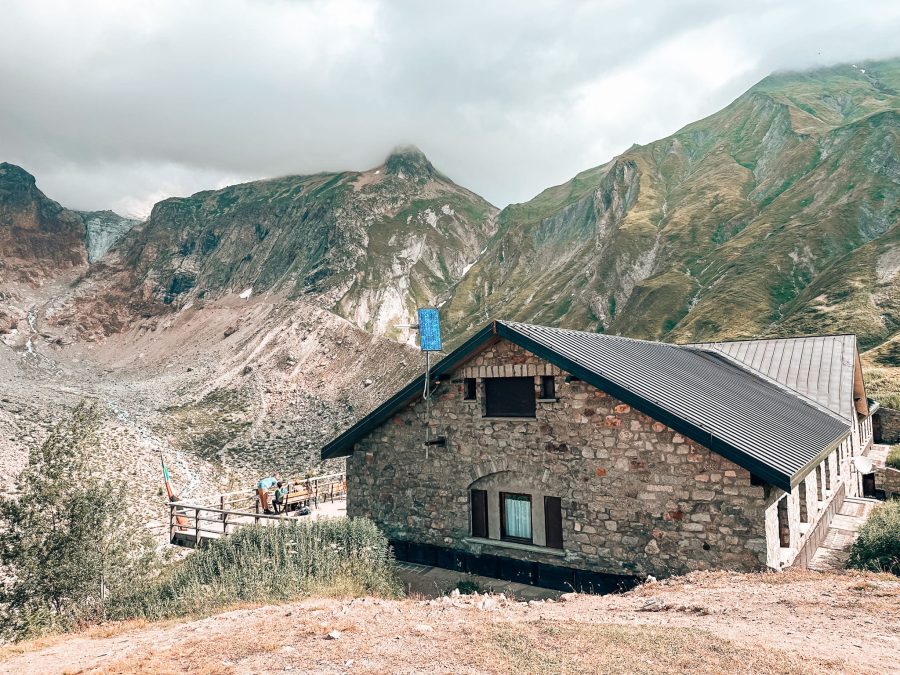
Along the trail, you’ll often pass refuges where you can buy lunch, snacks, coffee and drinks. Make sure you plan ahead with this option as there aren’t always refuges or you may pass one but not at lunch.
Our Top Tip: the best spot we visited for lunch in the mountains was Alpage de Bovine between Champex Lac and Trient. This cafe has incredible views over Martigny and serves delicious homemade food and treats.

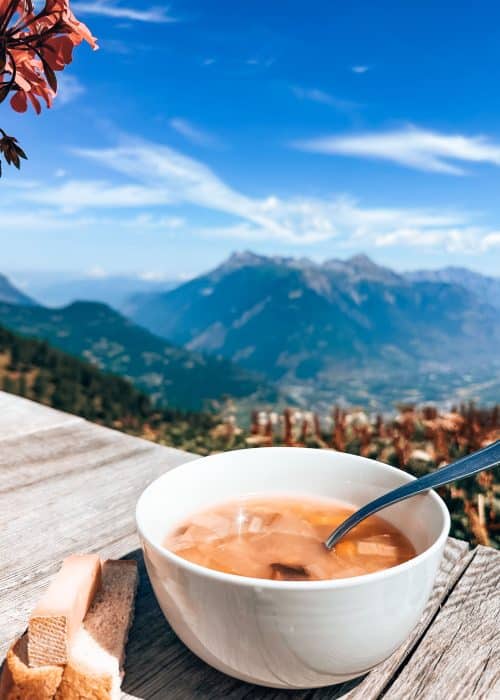
Drinking Water Along the TMB
We recommend bringing either a 2L Camelbak (or equivalent). 3L may be slightly excessive as there are plenty of places to refill from en route and it just adds to the weight. We had 3L and never fully filled or finished them.
Fill up at your accommodation before you leave then there are water fill-up points at regular intervals on the trail. You’ll only go a few hours between them. We never ran out of water and sometimes didn’t refill as we knew there was another one in a couple of hours.
For all of the water points on our route, read our TMB itinerary.
There are refuges you’ll pass as you hike which should all have somewhere to fill up water. You can also buy bottled water in towns but we never had to do this and we’d recommend not doing so unless desperate as it contributes to waste.
Our Top Tip: look for the words “eau potable” which means “drinking water”; “eau non-potable” means not drinking water. Also, avoid drinking out of streams and rivers as there are a lot of grazing cattle and this can lead to stomach bugs.
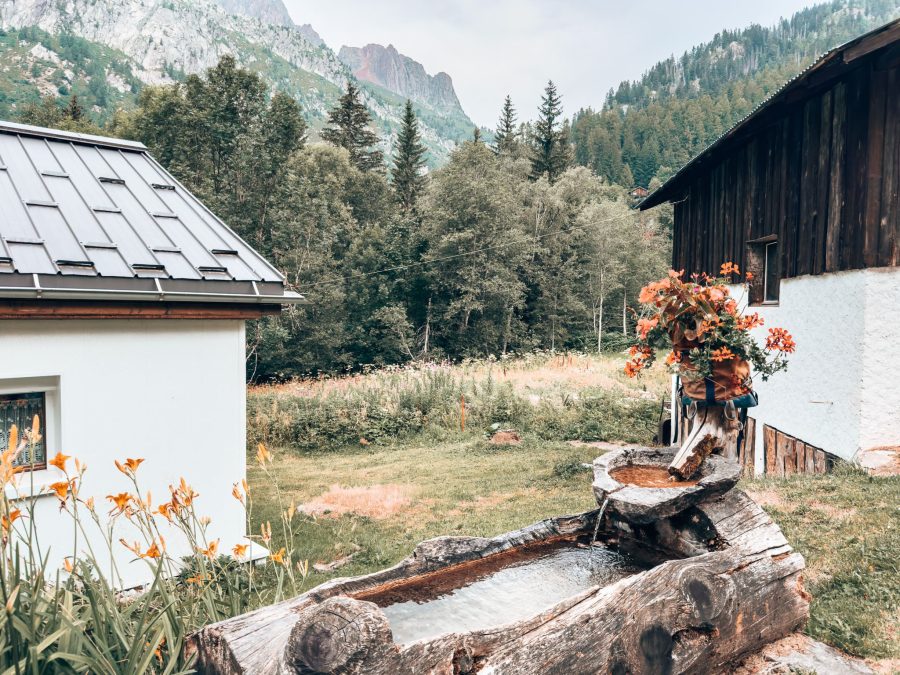
Currency, ATMs and Costs
Hiking the Tour du Mont Blanc you’ll need Euros for France and Italy and Swiss Francs for Switzerland. Currently, the exchange rate is 1 USD to 0.93 EUR and 0.88 CHF.
The majority of refuges don’t accept card payments and for the few that do, the connection is intermittent and can’t be guaranteed so you should come prepared with cash to be safe.
The easiest places to get cash are; Geneva on arrival, Chamonix and Courmayeur. We took out enough Swiss Francs at Geneva Airport for the accommodation in Switzerland, Euros in Chamonix for the first part of our trip and Courmayeur for the second part.
There are also ATMs in Les Houches, Les Contamines, La Fouly, Champex-Lac and Argentière so make sure you plan ahead and know where you’ll need money for.
We heard people say that the refuges in Switzerland will accept Euros, however, we didn’t try this so can’t confirm if it’s true.
As you’re going to be staying in remote accommodation and towns, things aren’t going to be cheap. For lunch in all 3 countries, expect to pay approximately €10-€15 for a packed lunch from a refuge, and €8-€10 from a supermarket.
Meals out in France and Italy can range between €15 and €25 with a pint of local beer between €7 and €10. In Switzerland, meals out were more expensive, starting around €23 but surprisingly, pints of local beer were cheaper at around €5-€7.
Can I Hike the TMB With My Dog?
Yes, you can hike the TMB with your dog. We saw many people doing so but there are some things to bear in mind.
- Refuges aren’t dog-friendly so if you’re staying in the mountains, you’ll need to camp. You can probably find accommodation in the towns that do accept dogs but none of the refuges will.
- Dogs will need to be on leads most of the time as there’s wildlife.
- Some parts of the trail are quite narrow and steep so be careful.
- To reach Lac Blanc from Tré-le-Champ, one of the routes has multiple ladders that dogs will not be able to climb. There is a slightly longer alternative route, however.
- You’ll need to carry all of your pooch’s food and probably a first aid kit for them as well just in case they get injured. Take this into account when packing.
Which Airport to Fly Into for Hiking the Tour du Mont Blanc
The closest airport to start the Tour du Mont Blanc hike is Geneva Airport in Switzerland. From Geneva, you can either book a private transfer to Chamonix or take the bus which will be cheaper but may make multiple stops en route.
What to Pack for Hiking the Tour du Mont Blanc
Thinking about what to pack for hiking the Tour du Mont Blanc can be quite daunting and stressful so here we’ve compiled our list of everything we took and we never felt like we were missing anything.
- Passport – with at least 3 months validity after your trip
- Lightweight backpack – between 30 and 35 litres
- Rain cover for your backpack
- Hiking shoes/boots
- Hiking poles
- 3 t-shirts
- 1 thin long-sleeved top
- 1 thick jumper/fleece – this can be used for hiking if it’s really cold but also in the evenings at the refuges
- 1 pair of shorts
- 1 hiking trousers – also water resistant
- 3 Merino wool hiking socks
- 4-5 pairs of breathable, quick-dry hiking underwear – these can be washed in sinks/showers along the route so you don’t need a pair for every day
- 2 sports bras for the ladies
- Hat for sunny days
- 1 pair of non-hiking socks for the evenings
- A change of clothes for when you’re not hiking – casual shorts, trousers and a clean t-shirt
- Raincoat
- Flip flops – for the refuges, to chill in the evenings and if you’re stopping in the towns
- First aid kit – plasters, compeeds, painkillers, ibuprofen, sports tape for an extra layer of protection, hayfever tablets, bite cream, deep heat and a massage ball can be quite useful
- Suncream
- Head torch
- Electrolytes or rehydration salts
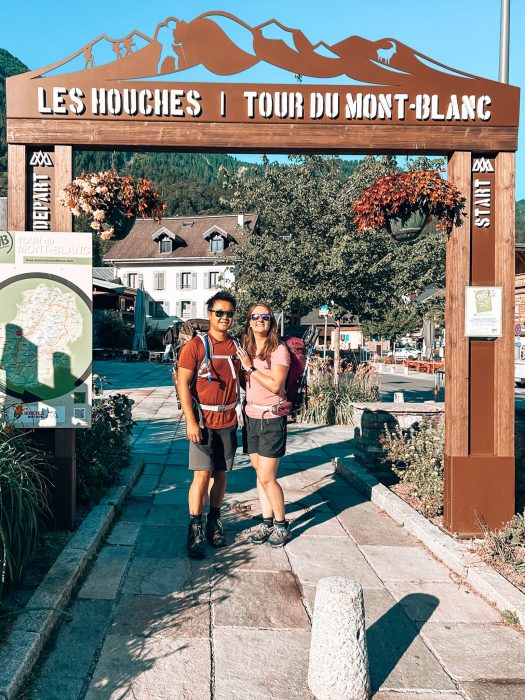
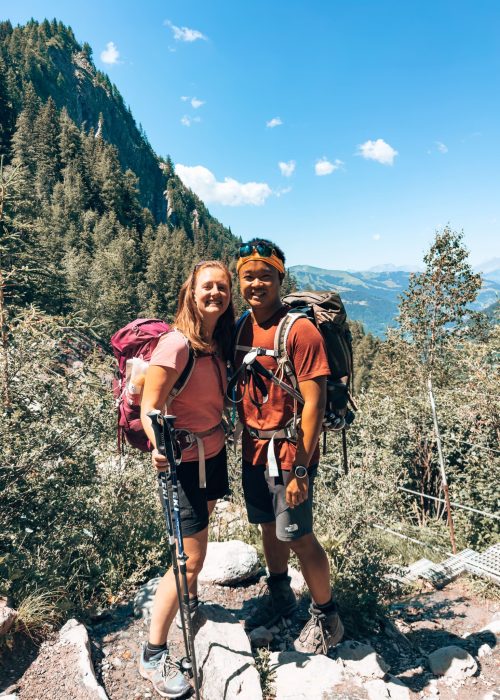
Hiking Shoes or Hiking Boots
One of the biggest questions we had before hiking the Tour du Mont Blanc was whether to hike in shoes or boots. In the end, I went for shoes and Andy and our 2 friends wore boots.
It essentially comes down to personal preference. I’m glad I had shoes and would wear them again, Andy wished he had shoes and our friends were happy with boots.
Yes, boots give you more support around the ankle but the paths are well-maintained so I didn’t feel like I especially needed them.
We 100% wouldn’t recommend trainers or anything with less support than hiking shoes.
Where can I Relax After Hiking the Tour du Mont Blanc?
After hiking the Tour du Mont Blanc, we’d recommend spending a few days in the fairytale town of Annecy.
Relaxing on Lake Annecy, eating the local specialities, drinking in cosy bars down quaint cobbled streets and exploring the medieval charm of the Old Town, Annecy is a great spot after hiking the TMB. Read our full guide on things to do in Annecy below.
Anything Else to Know for Hiking the Tour du Mont Blanc
Other bits to bear in mind when hiking the Tour du Mont Blanc are:
Altitude Sickness
Altitude sickness can affect anyone no matter your age and how fit you are. It can arise after spending at least 4 hours at an altitude of over 2000 metres and it can become very serious and potentially even fatal if ignored.
To reduce your chance of suffering from altitude sickness, if you know you’re going to be hiking to over 2000 metres, ascend slowly, take lots of breaks and drink plenty of water.
If you do find you’re suffering from altitude sickness, which Andy was for a few days, descend to a lower altitude and take a rest day if needed. If you’re in a town, speak to the pharmacy as it may be able to recommend some medication to treat it.
Signal
Although it was rare for us to not have a signal while hiking the TMB, it can be quite intermittent and unpredictable so don’t rely on it. There are some places where you won’t have any signal at all, such as Les Chapieux where there’s also no WiFi.
Refuges don’t have WiFi although most we found you could find at least 3G somewhere.
This is why it’s essential to bring a map rather than relying on online trail maps.
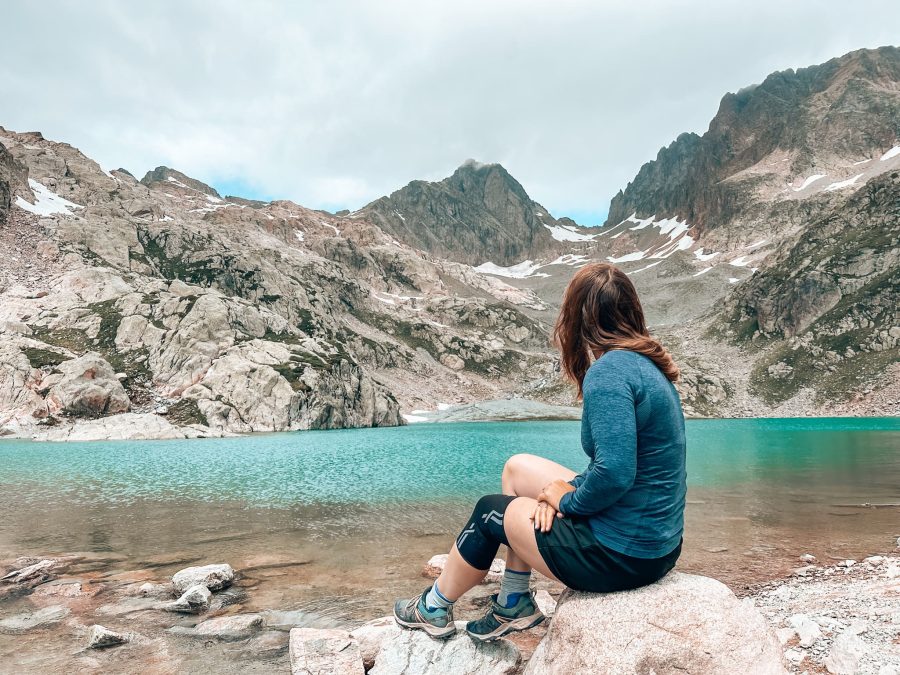
We hope you’ve enjoyed our guide to everything you need to know before hiking the Tour du Mont Blanc. If you have any questions, feel free to get in contact or leave a comment below 🙂

1 thought on “Everything You Need to Know Before Hiking the Tour du Mont Blanc”
nice information and good article thank you